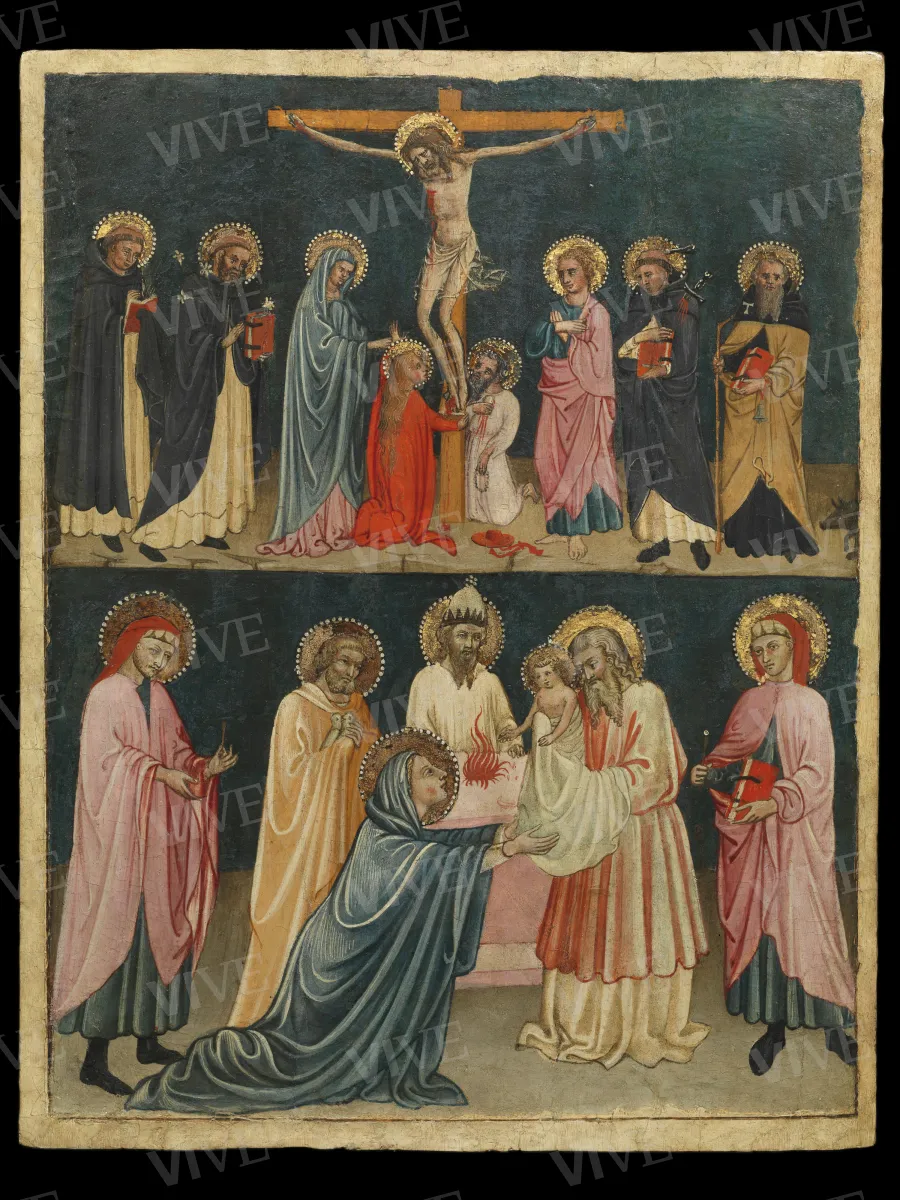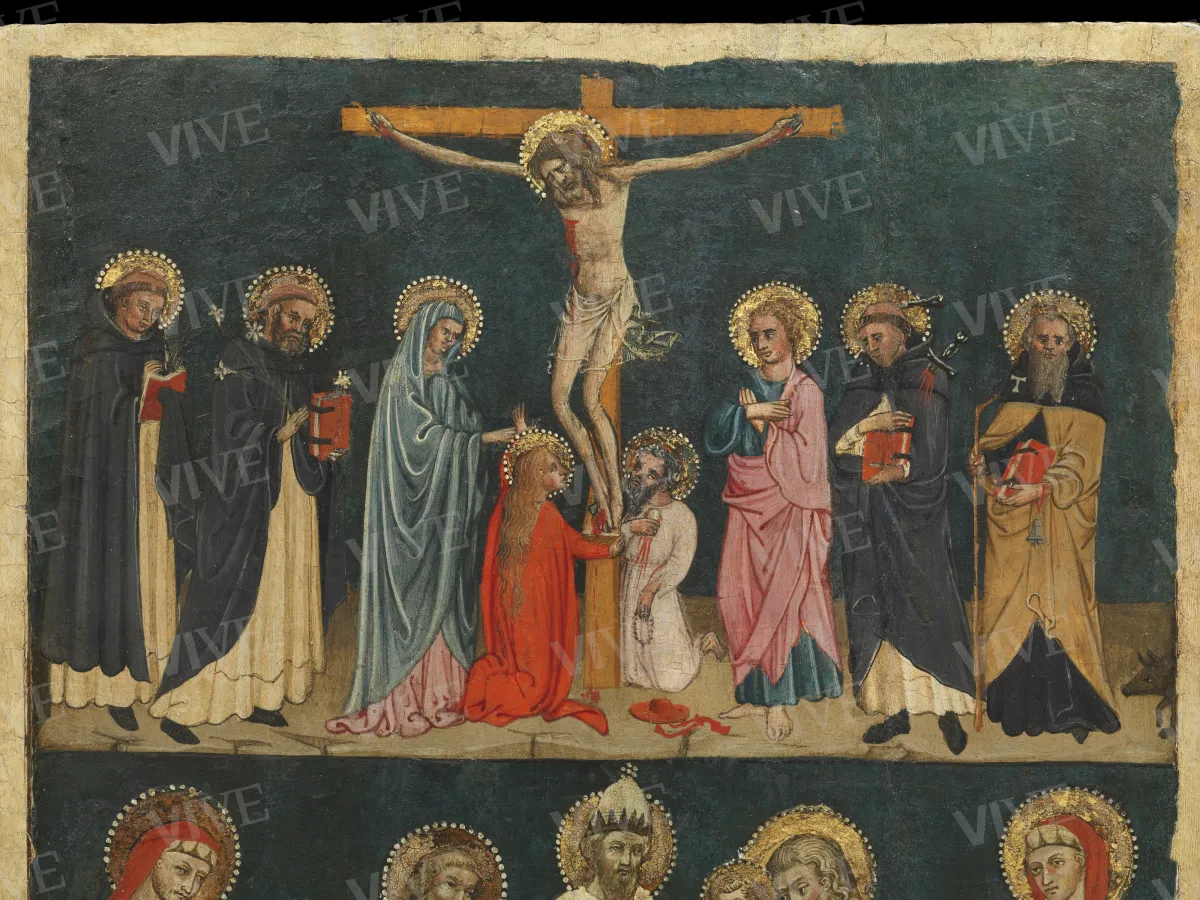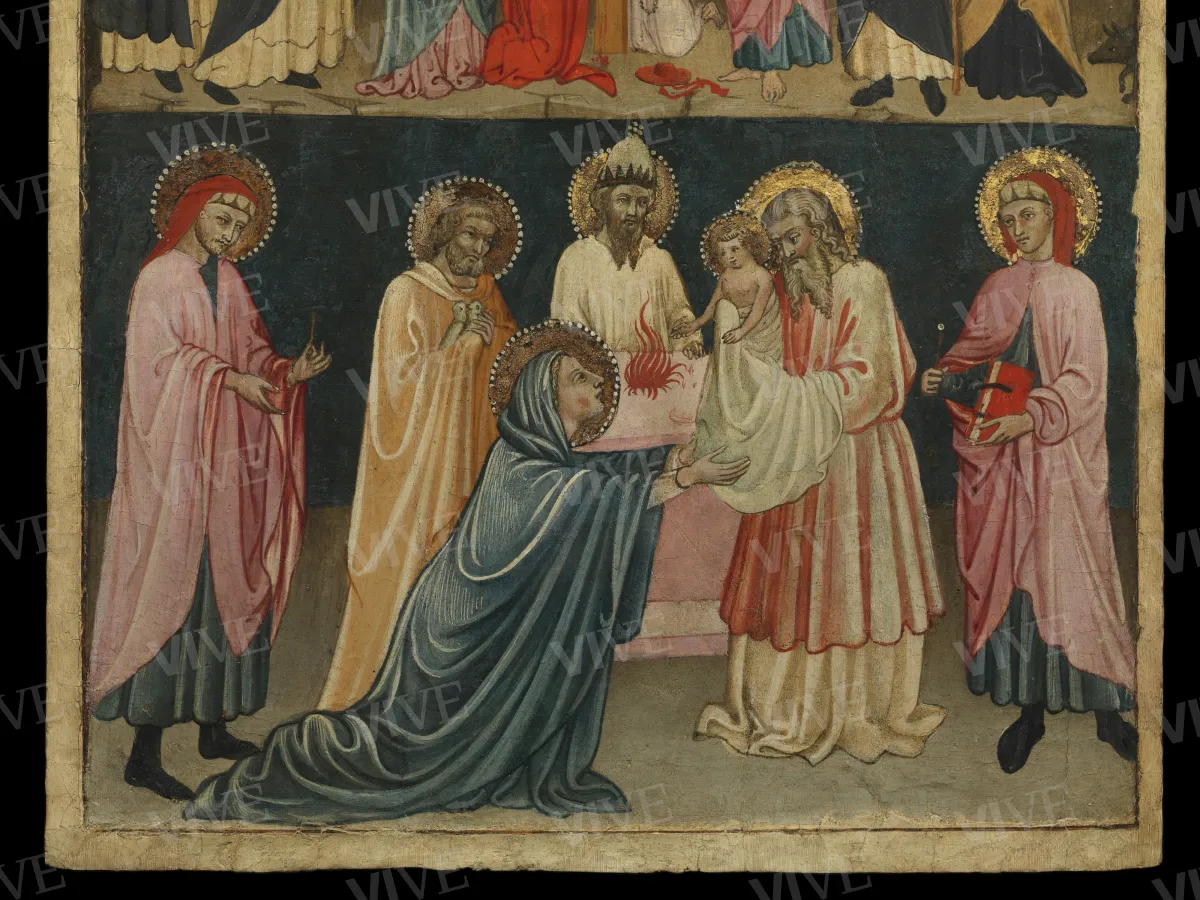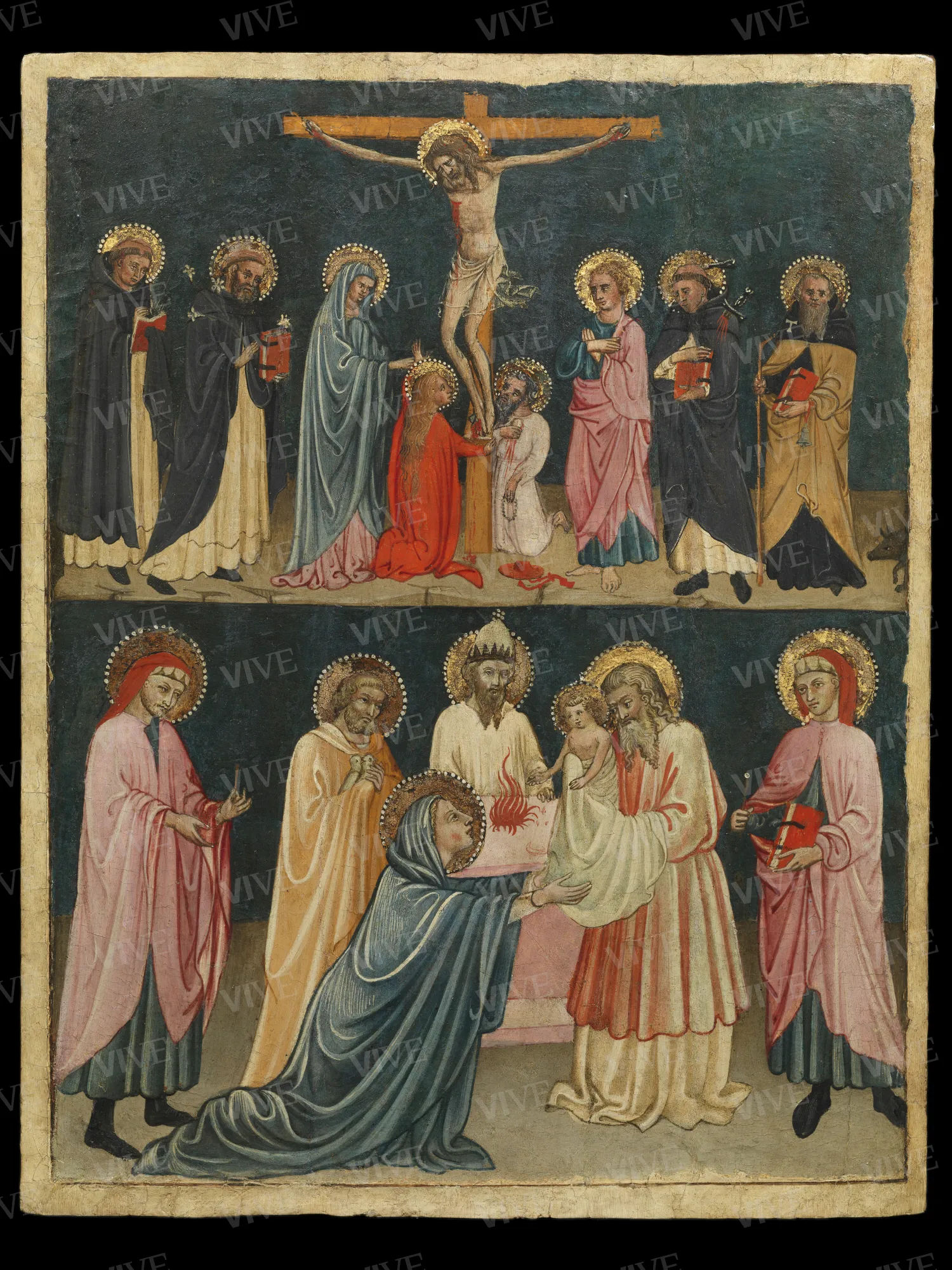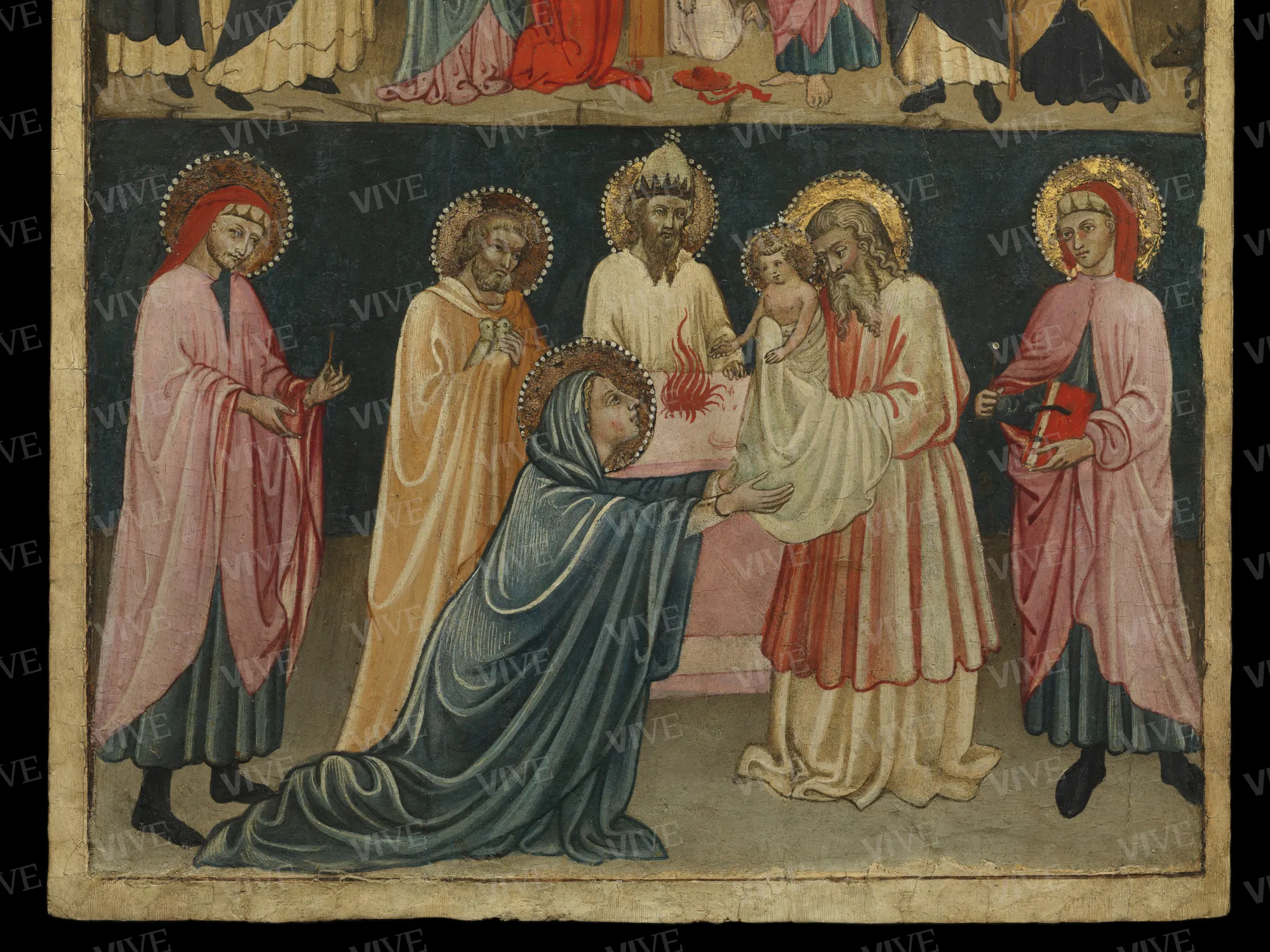Crucifixion with St Dominic, St Thomas Aquinas, the Virgin Mary, St Mary Magdalene, St Jerome, St John, St Peter the Martyr, St Anthony Abbot (upper register); Presentation of Jesus in the Temple between Sts Cosmas and Damian (lower register)
Francesco d’Antonio? Second quarter 15th century
The panel is divided into two registers depicting episodes from the life of Christ with various saints: the Crucifixion above, and the Presentation in the Temple below. The small figures are set against a dark background by their vivid draperies and gilded halos surrounding well-defined faces. This distinctive painting blends archaic and modern characteristics, and comes from the Florentine context of the first half of the fifteenth century. It has been suggested that Francesco d’Antonio is the author.
The panel is divided into two registers depicting episodes from the life of Christ with various saints: the Crucifixion above, and the Presentation in the Temple below. The small figures are set against a dark background by their vivid draperies and gilded halos surrounding well-defined faces. This distinctive painting blends archaic and modern characteristics, and comes from the Florentine context of the first half of the fifteenth century. It has been suggested that Francesco d’Antonio is the author.
Details of work
Catalog entry
The small panel consists of two registers depicting a Crucifixion with Saints and a Presentation in the Temple between Saints Cosmas and Damian, set against a dark background. In the lower section, the Virgin is shown kneeling in keeping with a less common depiction of the Presentation, which illustrates the moment when Simeon returns the Child to his mother (Réau 1957, II, p. 263).
The work, originally from the Sterbini collection, where it was categorized as part of the Emilian school, arrived at the Museo Nazionale di Palazzo Venezia in 1940 with the Armenise donation. Roberto Longhi attributed the panel to the Florentine school between the 1520s and 1530s, noting connections with Bicci di Lorenzo and Beato Angelico but in a more popular style (Santangelo 1947, p. 37). Federico Zeri, in the subsequent catalogue of the museum’s paintings, agreed with Longhi regarding the geographical origin of the author and the dating (Zeri 1955, p. 9, no. 139). Nonetheless, neither scholar could identify a specific artist with the painting, which is still attributed to an “anonymous Florentine.”
Angelo Tartuferi attributed the work to the later period of Francesco d’Antonio (1393/1394–post March 24, 1433), based on a comparison with the painter’s panel in the Montgomery Museum of Fine Arts (Longhi 1940, p. 187, note 24; De Marchi 1998, pp. 411, 424, note 83), which features similar stories divided into overlapping sections, and with the older frescoed Crucifixion in the church of San Francesco in Figline Valdarno (Tartuferi 2012, pp. 18–19, 53, no. 27). The Palazzo Venezia painting shows numerous compositional similarities with Montgomery’s panel, such as in the depiction of some of the saints, the slits in the ground’s outer edges in the upper section, and the arrangement of the characters. However, there are also some stylistic differences. The delicate transitions of colors, the flowing draperies, the animated postures of the figures, and the golden background that give the Montgomery piece a refined appearance, are replaced in the Palazzo Venezia painting by more static and markedly outlined figures, defined by a thin dark brushstroke on the faces and colored pigment on the robes, and set against a black background, which may have originally been blue. The light and shadow transitions here are rendered through the juxtaposition of different color tones and white highlights leaving visible brush marks, creating heavy, linear draperies with sharp contrasts, without the elegant, supple fluttering typical of International Gothic. The vivid portrayal of the crucified Christ appears to be derived from Nordic models. The archaic nature of the work is further emphasized by its lack of depth and setting, the highly characterized faces of the figures, and the use of golden halos surrounded by pearls, which seem to recall Byzantine painting models (Hélou 2006, p. 56, footnote 31).
Francesca Mari
Entry published on 27 March 2025
State of conservation
On the verso of the painting, there are traces of partially abraded pigment and a boarding consisting of two metal crosspieces, likely made of aluminum, supported by wooden dowels. Additionally, there are many added wooden brackets that appear to serve two purposes: some are used to repair vertical cracks that were then plastered over and reintegrated on the front; others, located on the perimeter and in the central band, were possibly applied to level out the verso of the panel.
Coats of arms, emblems, and marks
On the reverse a partially worn red wax seal.
Provenance
Rome, Collezione Giulio Sterbini;
Rome, Collezione Lupi Family, post 1911;
Rome, Collezione Giulio Armenise, 1940;
Rome, Museo Nazionale di Palazzo Venezia, from 1940.
References
Longhi Roberto, Fatti di Masolino e di Masaccio, in «Critica d’Arte», 25/36, 1940, pp. 145-191;
Santangelo Antonino (a cura di), Museo di Palazzo Venezia. Catalogo. 1. Dipinti, Roma 1947, p. 37;
Zeri Federico (a cura di), Catalogo del Gabinetto Fotografico Nazionale. 3. I dipinti del Museo di Palazzo Venezia in Roma, Roma 1955, p. 9, n. 139;
Réau Louis, Iconographie de l’art chrétien, II, Paris 1957;
De Marchi Andrea, Pittori gotici a Lucca: indizi di un’identità complessa, in Filieri Maria Teresa (a cura di), Sumptuosa tabula picta, catalogo della mostra (Lucca, Museo Nazionale di Villa Guinigi, 28 marzo-5 luglio 1998), Livorno 1998, pp. 400-425;
Hélou Nada, À propos d’une école syro-libanaise d’icônes au XIIIe siècle, in «Eastern Christian art», 3, 2006, pp. 53-72;
Tartuferi Angelo, Francesco d’Antonio a Figline Valdarno (e altrove), Figline Valdarno 2012, pp. 18-19, 53, n. 27.

